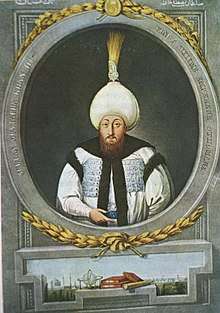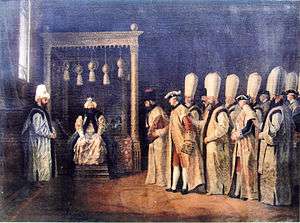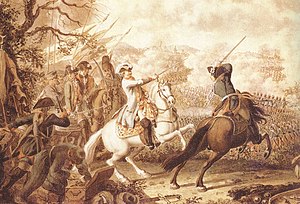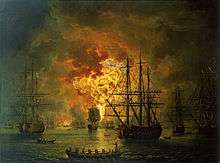Mustafa III
Mustafa III (/ˈmʊstəfə/; Ottoman Turkish: مصطفى ثالث Muṣṭafā-yi sālis; 28 January 1717 – 21 January 1774) was the Sultan of the Ottoman Empire from 1757 to 1774. He was a son of Sultan Ahmed III (1703–30), and his consort Mihrişah Kadın. He was succeeded by his brother Abdul Hamid I (1774–89).
| Mustafa III مصطفى ثالث | |||||
|---|---|---|---|---|---|
| Ottoman Caliph Sultan of the Ottoman Empire Kayser-i Rûm Custodian of the Two Holy Mosques | |||||
 | |||||
| 26th Ottoman Sultan (Emperor) | |||||
| Reign | 30 October 1757 – 21 January 1774 | ||||
| Predecessor | Osman III | ||||
| Successor | Abdul Hamid I | ||||
| Born | 28 January 1717 Edirne Palace, Edirne, Ottoman Empire | ||||
| Died | 21 January 1774 (aged 56) Topkapı Palace, Istanbul, Ottoman Empire | ||||
| Burial | Laleli Mosque, Fatih, Istanbul | ||||
| Consorts | Mihrişah Sultan Mihrişah Kadın Aynülhayat Kadın Adilşah Kadın Rif’at Kadın | ||||
| Issue | see below | ||||
| |||||
| Dynasty | Ottoman | ||||
| Father | Ahmed III | ||||
| Mother | Mihrişah Kadın | ||||
| Religion | Sunni Islam | ||||
| Tughra | |||||

-8478.jpg)
-8477.jpg)
Early life
Mustafa was born at the Edirne Palace on 28 January 1717.[1] His father was Sultan Ahmed III, and his mother was Mihrişah Kadın.[2] He had a full brother named, Şehzade Süleyman. In 1720, a large fifteen days circumcision ceremony took place for Mustafa, and his brothers, princes Süleyman, Mehmed, and Bayezid.[3] In 1730, after the Patrona Halil revolt, led to the deposition of his father Sultan Ahmed,[4] and the succession of his cousin Sultan Mahmud I, Mustafa, his father, and brothers were all locked up in the Topkapı Palace. In 1756, after the death of his half-brother Mehmed, he was only elder heir left for the throne.
Reign
Accession
Mustafa ascended the throne on 30 October 1757, after the death of his cousin Osman III, the son of Sultan Mustafa II.[5]
Character of Mustafa's rule
Soon after his accession to the throne, Mustafa demonstrated a special care for justice. He took a number of measures to increase prosperity in Istanbul. He regulated coinage, built large grain stores, maintained aqueducts, and established a strict fiscal policy.[6]
He traveled frequently and started to check whether the laws he had enforced were followed.[7] In February 1758, Mustafa launched a ship named Hısn-ı Bahri. He released prisoners from prison and the guards give them reminder that creditors should pay their debts.[8] In June 1758, when Ayşe Sultan’s husband Silahdar Mehmed Pasha returned from a journey, and Mustafa arranged dinner for him in the Bahariye Mansion. He also met his sister Esma Sultan in her palace.[8] On 14 March 1759, the birth of Mustafa’s first child Hibetullah Sultan, forty days celebrations were held, the city was decorated and prayers were prayed in the mosques for her long life. Shopkeepers reduced the prices on fruits and vegetables. [9]
Grand Vizier Ragıb Pasha, who had a complex built in Koska, died on 8 April 1763. Hamza Hamid Pasha was appointed instead. As well as being a good statesman, Ragıb Pasha was an exceptional state with his readiness, culture, rich, legal knowledge, poetry and conversations. So, Acem Ali, Hindi Hasan, Armenian Kazar and others were paying bribes to Ragıb Pasha. Acem Ali's neck, which got richer and gained palaces and mansions, was shot and Kazar was hung. [10]
On 28 March 1765, the Grand Vizier Köse Bahir Mustafa Pasha, who had a partnership with the corruption of Kethüda Ahmed Efendi, was dismissed from his position and was placed under arrest for two days. He was then exiled to Lesbos and executed there. Muhsinzade Mehmed Pasha became the Grand Vizier in his place. In April 1765, Bozok Mutasamfi Çapanoğlu Ahmed Pasha, who was executed for his persecution, was brought to Istanbul and exhibited in front of Bab-i Humayun.[11]
Treaty with Prussia
Mustafa much admired Frederick the Great's generalship, and in 1761 established a peace treaty with Prussia. Frederick wanted an alliance against the Habsburgs, and Mustafa wanted to modernize his state and army. Mustafa preferred recruiting his officers in Berlin, rather than in Paris and London, to re-organize his army. In 1763, the two countries exchanged their diplomats for the first time.[12]
Russo-Turkish War (1768–1774)
Koca Ragıp Pasha, who remained grand vizier until 1763, pursued a peace policy towards neighboring countries. But the increasing influence of Russia over the Caucasus and its intention to control Poland created tension between the Ottomans and Russia. Ragıp Pasha's successor Muhsinzade Mehmed Pasha also preferred to remain at peace, and Mustafa's insistence on war with Russia led to his resignation in 1768. The Sultan expected to gain an easy victory over the Russians, but in fact the Ottomans were unprepared for a long war. During the war, military reforms were undertaken, with the assistance of French officer François Baron de Tott. They included the modernization of artillery corps and the foundation of the Naval Engineering School in 1773. The war was disastrous for the Ottoman Empire. The Russian armies occupied the Crimea, Romania and parts of Bulgaria.[13]
 Russian forces charge against the Turk, Battle of Kagul, southern Bessarabia, 1770.
Russian forces charge against the Turk, Battle of Kagul, southern Bessarabia, 1770. The destruction of the Ottoman Turk fleet in the Battle of Chesme, 1770.
The destruction of the Ottoman Turk fleet in the Battle of Chesme, 1770.
Architecture
Many monumental buildings including the Fatih Mosque, which was built by Mehmed the Conqueror was rebuilt from the ground during his reign. In addition, he had built Laleli Mosque complex, and the shore along the Yenikapı filled to set up a new neighborhood. Apart from these, he undertook other construction projects after the earthquakes of 1766.[6]
Earthquake of 1767
On 31 January 1767, there was another very severe earthquake in evening. Thus, four major earthquakes ruined Istanbul in eight months. Everyone left the city life by setting up tents on the countryside. Mustafa III mobilised the treasury possibilities for the restoration of Istanbul as soon as possible. Tıfli Efendi, Mehmed Ağa to the city walls, Osman Efen from Yenişehir to Baruthane, Osman Efen to Saraçhane and Arasta, Atefzade Ömer Efendi to Enderun buildings, Hezarfen Kara Mustafa Ağa, Tophane to Yedikule, Tophane Mahmud Bey was appointed as the building chief for the reconstruction of Fatih Mosque and Tomb. The fire that broke out in a galleon made the anchored ships in Kalafaytri hold. Aynalıkavak Palace, Halıcıoğlu pier were burned while the boats that got fire wandered under the influence of winds and currents. [14]
Personal life
Poetry
He was a poet, his poetry being written under the pseudonym of Cihangir.[15]
(Ottoman Turkish)
“Yıkılupdur bu cihan sanma ki bizde düzele
Devleti çarh-ı deni verdi kamu müptezele
Şimdi erbab-ı saadette gezen hep hazele
İşimiz kaldı hemen merhamet-i lem yezele.”[16]
(Translation)
"This world has ruined, don't even think with us it recovers,
It was the lousy fate that has delivered the power to vulgars,
Now the perfidious ones have populated the Imperial Palace,
It's now the mercy of the everlasting God that runs our business.
Family
- Consorts
Mustafa had five consorts:
- Mihrişah Sultan (died 16 October 1805, buried in Mihrişah Sultan Mausoleum, Eyüp, Istanbul),[17] Senior Consort;[18]
- Mihrişah Kadın (died 1799, buried in Şah Sultan Mausoleum, Eyüp, Istanbul), Second Consort;[19][20]
- Aynülhayat Kadın (died 21 July 1764, buried in Mustafa III Mausoleum, Laleli Mosque, Istanbul), Third Consort;[21]
- Adilşah Kadın (died 19 December 1803, buried in Mustafa III Mausoleum, Laleli Mosque, Istanbul),[22] Third Consort;[23]
- Rif’at Kadın (died 25 December 1804, buried in Haydarpaşa Cemetery, Istanbul), Fourth Consort;[24][25]
- Sons
Mustafa had two sons:
- Selim III (24 December 1761 – 28 July 1808, buried in Mustafa III Mausoleum), with Mihrişah;
- Şehzade Sultan Mehmed (10 January 1767[26] – 12 October 1772, buried in Mustafa III Mausoleum, Laleli Mosque Istanbul);[27]
- Daughters
Mustafa had seven daughters:
- Hibetullah Sultan (14 March 1759 – 7 June 1762, buried in Mustafa III Mausoleum, Laleli Mosque, Istanbul),[28][29] with Mihrişah,[30][31] betrothed on 2 June 1759 to Mahir Hamza Pasha;[26]
- Şah Sultan (20 April 1761 – 11 March 1803, buried in Şah Sultan Mausoleum, Eyüp, Istanbul), with Mihrişah, married on 6 November 1778, Damad Seyyid Mustafa Pasha;[32][33]
- Mihrimah Sultan (4 November 1762[34] – 16 March 1764,[35] buried in Mustafa III Mausoleum, Laleli Mosque, Istanbul),[26] with Aynülhayat;[36][37]
- Mihrişah Sultan (9 December 1762[38] – 21 February 1769, buried in Mustafa III Mausoleum, Laleli Mosque, Istanbul);[39][40]
- Beyhan Sultan (15 December 1765 – 7 November 1824, buried in Mihrişah Sultan Mausoleum, Eyüp, Istanbul), with Adilşah, married on 22 April 1784 to Damad Celik Mustafa Pasha;[41][42]
- Hatice Sultan (14 June 1768 – 17 July 1822, buried in Mihrişah Sultan Mausoleum, Eyüp, Istanbul), with Adilşah, married on 9 November 1786 to Damad Seyyid Ahmed Pasha;[43][44]
- Fatma Sultan (9 January 1770 – 26 May 1772, buried in Mustafa III Mausoleum, Laleli Mosque, Istanbul),[27][40] with Mihrişah;[30]
Death
Mustafa died of heart attack[45] on Friday, [46] 21 January 1774, [46][47][48] at the Topkapı Palace, and was buried in his own mausoleum located at Laleli Mosque, Istanbul.[49] He was succeeded by his brother Abdul Hamid I.[50] His death left the empire struggling with economic and administrative problems.[51]
 Laleli Mosque tomb Sultan Mustafa III and son Selim III
Laleli Mosque tomb Sultan Mustafa III and son Selim III
References
- Brill, E. J. The Encyclopaedia of Islām: A Dictionary of the Geography, Ethnography and Biography of the Muhammadan Peoples, Volume 3, Part 2. p. 761.
- Faroqhi, Suraiya (November 29, 2005). Subjects of the Sultan: Culture and Daily Life in the Ottoman Empire. I. B. Tauris. p. 326. ISBN 978-1-850-43760-4.
- Murphy, Rhoads (October 20, 2011). Exploring Ottoman Sovereignty: Tradition, Image and Practice in the Ottoman Imperial Household, 1400-1800. A&C Black. p. 182. ISBN 978-1-441-10251-5.
- Keskiner, Philippe Bora (2012). Sultan Ahmed III (r.1703-1730) as a Calligrapher and Patron of Calligraphy. p. 58.
- Biographical Encyclopaedia of Islam, Volume 3. Cosmo Publications. 2006. p. 864. ISBN 978-8-130-70390-9.
- Ágoston 2009, p. 411.
- Sakaoğlu 2015, p. 334.
- Sakaoğlu 2015, p. 335.
- Sakaoğlu 2015, p. 336.
- Sakaoğlu 2015, p. 340.
- Sakaoğlu 2015, p. 342.
- Hermann, Rainer (June 16, 2014). Where is Turkey Headed?: Culture Battles in Turkey. Blue Dome Press. ISBN 978-1-935-29572-3.
- Somel, Selcuk Aksin (March 23, 2010). The A to Z of the Ottoman Empire. Scarecrow Press. p. 203. ISBN 978-1-461-73176-4.
- Sakaoğlu 2015, p. 343.
- Lord Kinross, Ottoman Centuries, (Perennial, 2002), 406.
- Yıkılupdur bu cihan sanma ki biz de düzele
- Uluçay 2011, p. 150-1.
- Kal'a, Ahmet (1998). İstanbul külliyâtı: İstanbul tarım tarihi, 1 (1743-1757), 2 (1757-1763). İstanbul Araştırmaları Merkezi. p. 218.
- Haskan, Mehmed Nermi (2008). Eyüp Sultan Tarihi - Volume 2. Eyüp Belediyesi Kültür Yayınları. p. 583. ISBN 978-9-756-08704-6.
- Sak, Osman; Çalışkan, İrfan (2002). Beşinci Eyüpsultan Sempozyumu. Eyüp Belediyesi Kültür ve Turizm Müdürlüğü. p. 124. ISBN 978-9-759-38441-8.
- Uluçay 2011, p. 150.
- Uluçay 2011, p. 149-50.
- Tarih dergisi, Issues 25-27. 1971. p. 141.
- Uluçay 2011, p. 151.
- Tarih ve toplum: aylık ansiklopedik dergi - Volume 24. İletişim Yayınları/Perka A. Ş. p. 59.
- Şemʼdânî-zâde Fındıklılı, Süleyman Efendi (1976). Aktepe, M.Münir (ed.). Şemʼdânî-zâde Fındıklılı Süleyman Efendi târihi Mürʼiʼt-tevârih-Volume II A. Edebiyat Fakültesi Matbaası. pp. 32, 50, 65, 95.
- Şemʼdânî-zâde Fındıklılı, Süleyman Efendi (1976). Aktepe, M.Münir (ed.). Şemʼdânî-zâde Fındıklılı Süleyman Efendi târihi Mürʼiʼt-tevârih-Volume II B. Edebiyat Fakültesi Matbaası. pp. 24, 89, 90.
- Uluçay 2011, p. 151-2.
- Sakaoğlu 2008, p. 466.
- İyianlar, Arzu (1992). Vâlide Sultanlar'ın İmar Faaliyetleri. İstanbul Üniversitesi Sosyal Bilimler Enstitüsü. pp. 167–8, 170–71.
- Dominic, Paulina D.; Roszak, Stanisław (2017). The Istanbul Memories in Salomea Pilsztynowa's Diary "Echo of the Journey and Adventures of My Life" (1760). pp. 52 n. 41.
- Uluçay 2011, p. 153-4.
- Sakaoğlu 2008, p. 468-69.
- Uluçay 2011, p. 152.
- Miovic, Vesna (2018). Per Favore Della Soltana: Powerful Ottoman Women and Ragusan Diplomats. p. 134.
- Uluçay 2011, p. 152-3.
- Sakaoğlu 2008, p. 482-83.
- Uluçay 1992, p. 153.
- Uluçay 2011, p. 153.
- Sakaoğlu 2008, p. 483.
- Uluçay 2011, p. 155-7.
- Sakaoğlu 2008, p. 472-73.
- Uluçay 2011, p. 157-8.
- Sakaoğlu 2008, p. 477.
- Palmer, Alan (May 19, 2011). The Decline and Fall of the Ottoman Empire. Faber & Faber. ISBN 978-0-571-27908-1.
- Sakaoğlu 2015, p. 346.
- Alexander, John T. (November 9, 1989). Catherine the Great: Life and Legend. Oxford University Press. p. 139. ISBN 978-0-199-87430-9.
- THE BIOGRAPHICAL DICTIONARY OF THE SOCITEY FOR THE DIFFUSION OF USEFUL KNOWLEDGE VOL. 1 PART II. 1842. p. 523.
- Ayliffe, Rosie (2003). Turkey. Rough Guides. pp. 147. ISBN 978-1-843-53071-8.
- Hill, George (September 23, 2010). A History of Cyprus, Volume 4. Cambridge University Press. pp. 94 n. 1. ISBN 978-1-108-02065-7.
- Ágoston 2009, p. 412.
Bibliography
- Uluçay, Mustafa Çağatay (2011). Padişahların kadınları ve kızları. Ankara, Ötüken.CS1 maint: ref=harv (link)
- A ́goston, Ga ́bor; Masters, Bruce Alan (May 21, 2010). Encyclopedia of the Ottoman Empire. Infobase Publishing. ISBN 978-1-438-11025-7.CS1 maint: ref=harv (link)
- Sakaoğlu, Necdet (2008). Bu mülkün kadın sultanları: Vâlide sultanlar, hâtunlar, hasekiler, kadınefendiler, sultanefendiler. Oğlak Yayıncılık. ISBN 978-9-753-29623-6.CS1 maint: ref=harv (link)
- Sakaoğlu, Necdet (2015). Bu Mülkün Sultanları. Alfa Yayıncılık. ISBN 978-6-051-71080-8.
External links

Mustafa III House of Osman Born: 28 January 1717 Died: 21 January 1774[aged 56] | ||
| Regnal titles | ||
|---|---|---|
| Preceded by Osman III |
Sultan of the Ottoman Empire 30 Oct 1757 – 21 Jan 1774 |
Succeeded by Abdul Hamid I |
| Sunni Islam titles | ||
| Preceded by Osman III |
Caliph of the Ottoman Caliphate 30 Oct 1757 – 21 Jan 1774 |
Succeeded by Abdul Hamid I |
